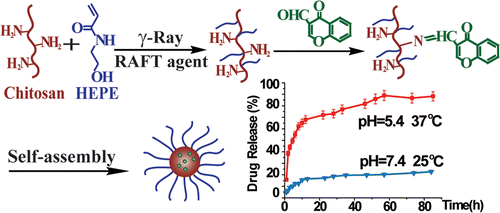Wei Huang †‡, Yingjie Wang †‡, Shuang Zhang †‡, Li Huang †‡, Daoben Hua *†‡(华道本), and Xiulin Zhu †
† Jiangsu Key Laboratory of Advanced Functional Polymer Design and Application, Department of Polymer Science and Engineering, College of Chemistry, Chemical Engineering and Materials Science, Soochow University, Suzhou 215123, P. R. China
‡ School of Radiation Medicine and Protection, and School for Radiological and Interdisciplinary Sciences (RAD-X), Medical College of Soochow University, Suzhou 215123, P. R. China
Macromolecules 2013, 46, 814–818.
(1→4)-2-Amino-2-deoxy-β-d-glucan (i.e., chitosan) is an abundant natural polysaccharide with huge availability and potential for biomedical applications due to its biocompatibility, biodegradability, and bioactivity, but its utilization in pharmaceutical formulations has been greatly limited by its intractability. We report here a novel, facile method of controlled modification of chitosan under γ-ray irradiation for drug delivery. Specifically, N-(2-hydroxyethyl)prop-2-enamide (HEPE) was grafted onto chitosan via a “one-pot” reversible addition–fragmentation chain transfer process under γ-ray irradiation, and then the unprotected amino group on chitosan was straightly used for the conjugation of chromone-3-carboxaldehyde. Importantly, there are no traditional protection–deprotection processes for amino groups of chitosan in this method. The conjugated graft copolymer can self-assembly into the micelles with the size of

链接: //pubs.acs.org/doi/abs/10.1021/ma302434c